Potrebujeme váš súhlas na využitie jednotlivých dát, aby sa vám okrem iného mohli ukazovať informácie týkajúce sa vašich záujmov. Súhlas udelíte kliknutím na tlačidlo „OK“.
ASTM E2927-13
Standard Test Method for Determination of Trace Elements in Soda-Lime Glass Samples Using Laser Ablation Inductively Coupled Plasma Mass Spectrometry for Forensic Comparisons
Automaticky preložený názov:
Štandardná skúšobná metóda pre stanovenie stopových prvkov v sodno-vápenaté sklo vzoriek pomocou laserovej ablácie s indukčne viazanou plazmou hmotnostnej spektrometrie pre forenznú Porovnanie
NORMA vydaná dňa 1.6.2013
Informácie o norme:
Označenie normy: ASTM E2927-13
Poznámka: NEPLATNÁ
Dátum vydania normy: 1.6.2013
Kód tovaru: NS-46274
Počet strán: 7
Približná hmotnosť: 21 g (0.05 libier)
Krajina: Americká technická norma
Kategória: Technické normy ASTM
Kategórie - podobné normy:
Anotácia textu normy ASTM E2927-13 :
Keywords:
forensic science, glass comparisons, glass measurement, trace elemental analysis, laser ablation, inductively coupled plasma mass spectrometry, LA-ICP-MS, ICS Number Code 07.140 (Forensic science), 71.040.40 (Chemical analysis), 81.040.10 (Raw materials and raw glass)
Doplňujúce informácie
| Significance and Use | ||||
|
4.1 This test method is useful for the determination of elemental concentrations in the microgram per gram (µgg-1) to percent (%) levels in soda-lime glass samples. A standard test method can aid in the interchange of data between laboratories and in the creation and use of glass databases. 4.2 The determination of elemental concentrations in glass provides high discriminating value in the forensic comparison of glass fragments. 4.3 This test method produces minimal destruction of the sample. Microscopic craters of 50 to 100 µm in diameter by 80 to 150-µm deep are left in the glass fragment after analysis. The mass removed per replicate is approximately 0.4 to 3.1 µg. 4.4 Appropriate sampling techniques should be used to account for natural heterogeneity of the materials at a microscopic scale. 4.5 The precision, accuracy, and limits of detection of the method (for each element measured) should be established in each laboratory that employs the method. The measurement uncertainty of any concentration value used for a comparison should be recorded with the concentration. 4.6 Acid digestion of glass followed by either Inductively Coupled Plasma-Optical Emission Spectrometry (ICP-OES) or Inductively Coupled Plasma-Mass Spectrometry (ICP-MS) may also be used for trace elemental analysis of glass, and offer similar detection levels and the ability for quantitative analysis. However, these methods are destructive, and require larger sample sizes and much longer sample preparation times (Test Method E2330). 4.7 Micro X-Ray Fluorescence (µ-XRF) uses comparable sample sizes to those used for LA-ICP-MS with the advantage of being non-destructive of the sample. Some of the drawbacks of µ-XRF are poorer sensitivity and precision, and longer analysis time. 4.8 Scanning Electron Microscopy with EDS (SEM-EDS) is also available for elemental analysis, but it is of limited use for forensic glass source discrimination due to poor detection limits for higher atomic number elements present in glass at trace concentration levels. However, distinguishing between sources having similar RIs and densities is possible. |
||||
| 1. Scope | ||||
|
1.1 This test method covers a procedure for the quantitative elemental analysis of the following seventeen elements: lithium (Li), magnesium (Mg), aluminum (Al), potassium (K), calcium (Ca), iron (Fe), titanium (Ti), manganese (Mn), rubidium (Rb), strontium (Sr), zirconium (Zr), barium (Ba), lanthanum (La), cerium (Ce), neodymium (Nd), hafnium (Hf) and lead (Pb) through the use of Laser Ablation Inductively Coupled Plasma Mass Spectrometry (LA-ICP-MS) for the forensic comparison of glass fragments. The potential of these elements to provide the best discrimination among different sources of soda-lime glasses has been published elsewhere (1-5).2 Silicon (Si) is also monitored for use as an internal standard. Additional elements can be added as needed, for example, tin (Sn) can be used to monitor the orientation of float glass fragments. 1.2 The method only consumes approximately 0.4 to 2 g of glass per replicate and is suitable for the analysis of full thickness samples as well as irregularly shaped fragments as small as 0.1 mm by 0.4 mm in dimension. The concentrations of the elements listed above range from the low parts per million (µgg-1) to percent (%) levels in soda-lime-silicate glass, the most common type encountered in forensic cases. This standard method may be applied for the quantitative analysis of other glass types; however, some modifications in the reference standard glasses and the element menu may be required. 1.3 This standard does not replace knowledge, skill, ability, experience, education or training and should be used in conjunction with professional judgment. 1.4 The values stated in SI units are to be regarded as standard. No other units of measurement are included in this standard. 1.5 This standard does not purport to address all of the safety concerns, if any, associated with its use. It is the responsibility of the user of this standard to establish appropriate safety and health practices and determine the applicability of regulatory limitations prior to use. |
||||
| 2. Referenced Documents | ||||
|
Podobné normy:
Historická
1.6.2013
Historická
1.2.2006
Historická
1.10.2012
Historická
1.2.2012
Historická
1.5.2014
Historická
15.6.2012


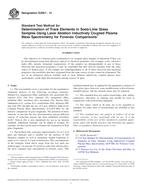
 ASTM D6143-13
ASTM D6143-13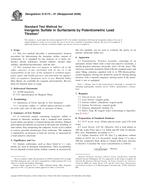 ASTM D6174-01(2006)..
ASTM D6174-01(2006)..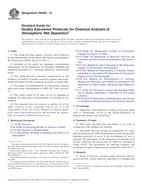 ASTM D6328-12
ASTM D6328-12 ASTM D6348-12e1
ASTM D6348-12e1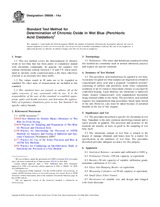 ASTM D6656-14a
ASTM D6656-14a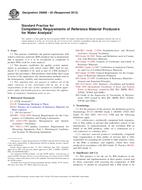 ASTM D6808-02(2012)..
ASTM D6808-02(2012)..
 Cookies
Cookies
